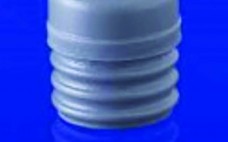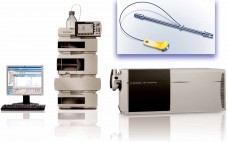To drive efficiencies in producing parenteral drug products, manufacturers are using containers and closure components that are received sterile and ready to be introduced into filling lines. The effects of sterilization on the properties of ready-to-use (RU) components must be assessed to ensure proper processing techniques and suitability over the components’ intended shelf lives. Sterile-drug manufacturers must determine the best sterilization method for components based on their respective drug products and processes. Critical areas of risk include potential changes related…
Formulation
Replacing Reverse-Phase Chromatography for Mass Spectrometry: Is Salt-Free Size-Exclusion Chromatography Ready?
Protein mass is often determined using ultraperformance liquid chromatography (UPLC) coupled with electrospray-ionization mass spectrometry (UPLC/ ESI MS or simply LC-MS). A UPLC system equipped with an ultraviolet (UV) detector serves as an assisting vehicle to deliver purified and separated protein molecules to the mass analyzer. Reserved-phase chromatography (RPC) is the most common chemistry chosen to serve this purpose. For sample purification, not only does RP-UPLC use salt-free mobile phases that are amenable to MS, but it also can efficiently…
Highly Concentrated Protein Formulations: Finding Solutions for the Next Generation of Parenteral Biologics
Therapeutic protein formulation is no easy task. Biological drugs may be destined for prefilled syringes or glass vials, or they may be made into lyophilized powders that will be reconstituted in a clinical setting. No matter what their final state will be, recombinant proteins must remain potent and efficacious during storage. In recent years, pharmaceutical companies have turned increasingly to high-concentration protein formulations. Such drug formulations can offer patients the convenience of self-injection — instead of a trip to the…
Accounting for the Donnan Effect in Diafiltration Optimization for High-Concentration UFDF Applications
The biopharmaceutical industry is targeting high-concentration protein formulations to enable subcutaneous administrations. Such administration can provide better patient convenience than intravenous administration. One challenge associated with high-concentration formulations is increased electrostatic interaction between proteins and excipients. That is a result of increased protein-charge density at high protein concentrations. Such interactions can create an offset between excipient levels in final products and diafiltration buffers in ultrafiltration processes. The effect of such electrostatic interactions in a membrane process is known as the…
Innovation in Biopharmaceutical Manufacture
The following is a report from a workshop on innovation in biopharmaceutical manufacturing held at the Annual bioProcessUK Conference in Bristol on 29 November 2012. The aim of the workshop was to access the experience of practitioners in the United Kingdom so as to understand better the challenges and opportunities for innovation in this sector. The workshop addressed the drivers that influence the implementation of process improvements and novel technologies in biopharmaceutical manufacture from the perspective of both manufacturers and…
Enabling Technologies
We hear a great deal lately about the maturation of the biopharmaceutical industry — and much advancement over the past decade or so has been in business models, financing, and product pipelines. Meanwhile, regulators around the world have become more well versed in the subject matter and have adjusted their approaches to and expectations from the industry. However, the practical side of developing, characterizing, and manufacturing biotherapeutic products cannot be overlooked — nor its importance overstated. Many technological…
How to Hit a Moving Target
Although multiple factors can compromise the drug-like properties of biological molecules, we are still at a very early stage in learning how to assess them. This is despite — or perhaps more correctly, because of — the pharmaceutical industry’s accelerating drive to develop biological molecules as therapeutic agents. And I say “we” because this applies not only to the biopharmaceutical industry itself and the analytical instrument companies that serve it, but also those charged with regulating it. We are all…
Spray-Dry Manufacture of Vaccine Formulations
Development of vaccines and immunotherapeutics has expanded rapidly due to technological advances in the fields of molecular biology and bioprocess engineering, as well as a smoothing of management and material logistics worldwide. Expression platforms and novel cell lines have enabled creation of increasingly complex vaccines. The advancement of vaccine formulation development is also capitalizing on new advances in manufacturing that use model-based methodologies gleaned from physiochemical principles, process analytical tools, and systematic approaches to problem solving. Herein we highlight recent…
Upstream Chemistry Analysis in Cell-Based Process Development
Cell line selection is important to any pharmaceutical company’s development pathway for biological compounds (1). In cell-line selection laboratories, many different, slightly variable cell lines are tested in parallel for desired characteristics. Candidate cell lines are chosen for further development on the basis of their performance in basic tests of critical quality attributes (CQAs). Historically, such cell lines were selected in large-volume containers because it was necessary to have sufficient volume in culture to allow repeated sampling without damaging the…
Biosimilars, Oxidative Damage, and Unwanted Immunogenicity
Concerns about the economic viability of biosimilars center on their high development cost relative to small-molecule generics, along with (and partly because of) the difficulty in demonstrating bioequivalence for these complex molecules. Immunogenicity is a particular area of increasing vigilance at both the US Food and Drug Administration (FDA) and the European Medicines Agency (EMA) (1, 2). Unwanted immunogenicity is an underlying cause of multiple deleterious effects for all protein-based therapeutics — including loss of efficacy, altered pharmacokinetics, and reduced…



